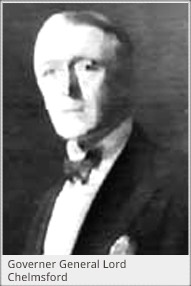In World War I, the British claimed that they stood for the protection of democracy around the world. Thus the Indians, who fought for them in this war, demanded that democracy should also be introduced in their country. In his famous August Declaration presented before the House of Commons on August 20 1917, Montague, the Secretary of State for Indian Affairs said that in order to satisfy the local demands, his  government was interested in giving more representation to the natives in India. New reforms would be introduced in the country to meet this objective. He came to India and stayed here for six months. During this period he held meetings with different government and non-government people. Finally, in cooperation with the Governor General Lord Chelmsford, Montague presented a report on the constitutional reforms for India in 1918. The report was discussed and approved by the British Parliament and then became the Act of 1919. This Act is commonly known as Montague-Chelmsford Reforms.
government was interested in giving more representation to the natives in India. New reforms would be introduced in the country to meet this objective. He came to India and stayed here for six months. During this period he held meetings with different government and non-government people. Finally, in cooperation with the Governor General Lord Chelmsford, Montague presented a report on the constitutional reforms for India in 1918. The report was discussed and approved by the British Parliament and then became the Act of 1919. This Act is commonly known as Montague-Chelmsford Reforms.
The following were the main features of the Act of 1919:
- The Council of the Secretary of State was to comprise of eight to twelve people. Three of them should be Indian, and at least half of them should have spent at least ten years in India.
- The Secretary of State was supposed to follow the advice of his council.
- Part of the expenses of the office of the Secretary of State was to be met by the British Government. The Secretary of State was not allowed to interfere in administrative matters of the provinces concerning the ‘Transferred Subjects’ and also in the matters on which Governor General and his Legislative were in agreement.
- The Governor General had the power to nominate as many members to his Executive Council as he wanted.
- Members appointed to the Executive Council were to have served in India for at least 10 years.
- The Central Legislature was to consist of two houses i.e. the Council of the State (Upper House) and the Legislative Assembly (Lower House).
- Council of the State was to consist of 60 members out of which 33 were to be elected and 27 nominated by the Governor General.
- The Legislative Assembly was to consist of 144 members out of which 103 were to be elected and 41 to be nominated by the Governor General.
- The franchise was limited.
- The tenure of the Upper House was five and of the Lower House was three years.
- Both the houses had equal legislative powers. In case of a tie, the Governor General was to call a joint meeting where the matter was to be decided by majority vote.
- The Executive Council was not responsible to the Legislature and the Governor General had the right to refuse its advice. Provincial Legislatures were supposed to be unicameral.
- Seventy percent members of the Provincial Legislative Councils were to be elected and thirty percent were to be nominated.
- The Governors were given ‘Instrument of Instructions’ which guided them in carrying out their administrative affairs.
- The System of Diarchy was introduced in the provinces.
- Besides Muslims, other minorities including Sikhs, Anglo-Indians, Christians and Europeans were also given the right of separate electorate.
- New reforms were to be introduced after ten years.
The Montague-Chelmsford reforms were not accepted by most quarters in India as they fell far short of the Indian natives’ expectations.
This article was last updated on Sunday, June 01, 2003






